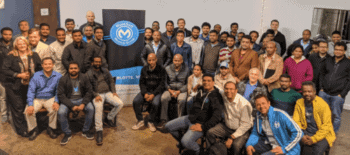Last month, Silverline sponsored MuleSoft CONNECT, a global integration conference. MuleSoft users, partners, customers, and thought leaders gathered over two days to participate in and facilitate inspiring keynotes, product highlights, breakout sessions, hands-on trainings, and more. Attendees learned to design, build, and manage integrations and APIs, and strategize on how to achieve their IT and business goals. In case you missed it, here’s our take on one of the most influential keynotes of the event.
The democratization of innovation
MuleSoft founder Ross Mason delivered a keynote discussing how MuleSoft’s Anypoint Platform provides a seamless way to leverage digital assets across your organization.
Mason highlighted how our economy is experiencing a fundamental shift in terms of how organizations innovate and noted that many large organizations are primed for operational scale, but it’s much more difficult for them to innovate.
Nowadays, innovation happens most effectively in ecosystems in order to deliver new products and services more quickly with division of concerns and labor. The net result of this change in dynamics is a huge cultural shift wherein IT needs to move from taking orders to designing the innovation agenda and soliciting engagement from business stakeholders and executives alike to drive value for their organizations.
Innovation: the cultural imperative
Every organization needs to consider the building blocks of innovation. What are the APIs that will power the next generation of innovation in order to have a solid foundation for apps and product experiences your company is offering?
By packaging up services and data as APIs, this allows for more experimentation with go-to-market strategies, new products, and new services in order to unlock greater value in bringing to life the best ideas in an organization.
The first place to start with your innovation agenda is getting better at delivering the services your company is already great at — focusing on being better, faster, and more intuitive. The next step is to address the cultural baseline necessary for innovation; this is to say that traditionally siloed teams (like IT and business) are not equipped to deliver seamless experiences because the data is difficult to access. When there’s not a feedback loop, the imperative for future innovation gets lost in translation.
The fundamentals of innovation require human intervention, unstructured thinking, and creativity in response to these big cultural shifts, and that requires permission for lateral thinking, the empowerment of ideas, execution, and measurement of new, innovative projects. Because of this, things need to start at the top.
Revolution: changing your culture
From the executive team down, first define what are the true assets and value your firm delivers: the experiences, the products, the benefits. Document answers to questions like:
- How are they delivered today?
- What is the speed of delivery?
- What is the quantitative impact of that value? The qualitative?
From there, a change in mindset must emerge. In an inside-out approach, the business leaders must establish a feedback loop with centralized IT that executes and optimizes against an innovation agenda. In an outside-in approach, the experience is what matters. What is the employee experience the innovation agenda is trying to drive? The customer experience? Ideally, the latter is the evolution because it’s focused on delivering human-centric design and value.
What is the value of an API-first strategy?
The first consideration to address is how can you leverage your digital assets. What data domains exist within your organization? How are they used? Who are your internal and external clients and what value do they see from these data domains and digital assets? The first step is defining these elements so that it’s clear to your stakeholders what exists and why it’s important.
Once this definition occurs, the API-first strategy begins to introspect how to unlock the maximum value from these data domains. In order to do just that, the next step in the process involves development of the system APIs that tap into these data domains and the creation of process APIs that funnel these data domains into meaningful ways to power your business. The goal of this work is to normalize and aggregate systems into an abstracted model that is engineered to unlock value through pragmatic application to business process tooling.
Experience APIs
Once these system and process APIs exist, a well-designed API-first strategy evolves into the development of Experience APIs. This follows next as a mechanism to support the purposeful manifestation of process and system APIs across different form factors, apps, and products that begin to consider the user experience and align to consumer value. This is where go-to-market strategy, focus group testing and research, and commercial development occurs. API-first strategy empowers this phase to happen much faster.
The next consideration of API-first strategies involves the extension into your ecosystem and the nurturing thereof. If you can expose APIs to partners, to developers, to customers — what ideas will originate? What innovative new value streams will emerge? By providing ecosystem opportunities, this can help improve the overall pace of innovation for your firm.
The benefits of ecosystems
What emerges is an application network, which creates a foundation for ecosystems with compelling building blocks:
- Fast and agile by design with pluggable, reusable building blocks
- Secure across endpoints to provide built-in visibility and governance at every node
- Dramatically lower total costs through lower development costs, reuse, and self-service
- Democratized innovation in which the leverage of digital assets extends into your partner ecosystem, your clients’ direct access, and beyond
Mason argued that the benefits of API-first ecosystems are realized in compounded value. This starts with unlocking 2.5x value in integration effort project over project, unlocking 5x value in API-led connectivity and experience agility, and the realization of 10x value in innovation strategy. When the API ecosystems emerge your firm can collaborate with external parties to think outside the box and deliver greater market value. He argued that, for every project that emerges over a given timeframe thereafter, IT projects realize this value tenfold.
—
If you’re ready to bring innovation into your org, Silverline can help you with our MuleSoft solutions.




